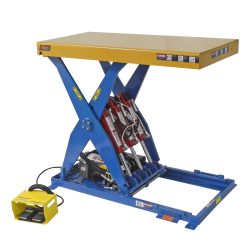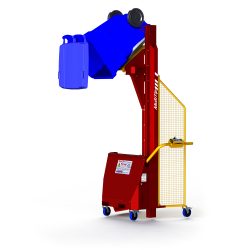We use cookies to make your experience better. To comply with the new e-Privacy directive, we need to ask for your consent to set the cookies. Learn more.
How Ergonomic Material Handling Increases Productivity
To improve productivity in material handling applications, make the job easier for your staff.
That statement might sound overly simple, or even counterintuitive. In fact, safety and efficiency are closely linked in the material handling world. Sure, there was a time when safety and efficiency were placed on opposite ends of an imaginary spectrum — but the explosion of ergonomics research over the past half-century has proven that model false. In fact, by implementing key ergonomic improvements that protect workers, industrial facilities can achieve leaner, more productive operations every time.
The central goal of ergonomics helps to explain this dynamic. The Occupational Safety and Health Administration describes ergonomics as "the science of designing the job to fit the worker, rather than physically forcing the worker's body to fit the job."
Succeed at this task to prevent wasteful, dangerous bodily movements. Ergonomic guidelines align efficiency and comfort. And, as we'll see, this benefit-driven approach to ergonomics dovetails with key productivity strategies, including lean methodologies.
As tech business leader Jim Rock writes in the journal Industrial Engineer, "Safety drives innovation and lean manufacturing. Innovation drives safety and lean manufacturing. Lean manufacturing drives safety and innovation."
In this article, we will demonstrate the clear link between safety and productivity. We aim to show that, by instituting a comprehensive ergonomics plan, any employer can cut down on common musculoskeletal injuries at warehouses, manufacturing facilities, construction sites, and more. Keep reading to discover how that can improve productivity along the way.
More Comfortable Work is Often Faster, More Accurate Work
When you remove a workplace bottleneck, you may inadvertently create a safer, more comfortable work environment. The converse is also true — often, comfortable workstations lead to a more productive workforce. Just ask Jim Galante, chairman of industry association MHI's Ergonomic Assist Systems and Equipment Council (EASE).
“You almost can’t have one without the other, since wasted motion, energy, or some wasted resource is the root cause," Galante told trade journal Modern Materials Handling, referring to the link between productivity and ergonomics. "It’s clear that lean methodologies and ergonomics are tied very closely.”
Galante is right. One of the pillars of the "lean" industrial philosophy is the attempt to eliminate wasteful uses of time. Industry journal Inbound Logistics describes one goal of lean warehousing as "reducing the time it takes to complete a task is a strong competitive advantage in today's environment." The article goes on to instruct us to "look for ways to eliminate non-value added activity and waste from every step in the process."
When you apply these principles to the biomechanical realities of manual material handling, you see that the very actions that decrease efficiency are the ones that create the risk of musculoskeletal disorders. Reaching, stretching, lifting above capacity; all of these things wear on the human body at the same moment that they're wasting valuable time.
Besides, injured workers have to miss work for treatment and recuperation. While injured employees heal, their employers may continue to pay for tasks twice — through sick pay and a temporary replacement. The only other option is to place a greater burden on other employees, taxing their morale. This brings us to our next point:
Use Ergonomics to Reduce Staff Injuries, Reducing Sick Pay and Lost Working Hours
Poor ergonomics leads to higher rates of musculoskeletal disorders (MSDs). If you've spent a long time working in a job that requires manual material handling, you've probably suffered from an MSD yourself. Think sprains, strains, and chronic conditions like tendinitis and carpal tunnel syndrome. Even arthritis can sometimes be traced back to a poorly planned work environment.
These injuries are more serious than they sound, and not just to those afflicted. Whether they know it or not, employers have a strong financial incentive to eliminate MSDs in their workplaces. In 2015, MSDs accounted for nearly a third of all workplace injuries that required days away from work, reports the Bureau of Labor Statistics. Workers in the private sector who contracted MSDs required a median of 12 days before returning to work that year.
These costs add up. According to the United States Bone and Joint Initiative, musculoskeletal disorders cost the American economy a total of $213 billion in 2011. At the time, that figure represented 1.4 percent of the U.S. Gross Domestic Product.
The financial drawbacks of poor ergonomics are dwarfed by the human costs of musculoskeletal disorder, of course. The first and greatest reason that employers adopt smarter ergonomic techniques is to keep their staff happy and healthy; it's just a happy coincidence that this also pays dividends on the company's bottom line.
Improve Ergonomics to Cut Down on Turnover
Unhappy employees don't stick around. Improving worker comfort can go a long way toward building a stable, long-term workforce, which translates directly into financial benefits for the organization.
How much money can companies save by instituting ergonomic reforms? Every case is different, but the Spine Research Institute at Ohio State University tells us in no uncertain terms that "investing in ergonomics can help you reduce your organization’s employee turnover costs."
The same article quotes a paper from the American Center for Progress that reports the total median cost of replacing an employee equals 21 percent of that employee's annual paycheck. If an employee who makes $50,000 per year gets injured and quits, the employer might be on the hook for $10,500. Spending even a fraction of that amount on ergonomic warehouse equipment that would prevent the worker's injury in the first place achieves an immediate ROI.
Material Handling Equipment for Safety and Productivity
In most of the English-speaking world, ergonomics are a matter of law. They sort of are in the United States, too, although that's a long story. Among the nations that have written regulations requiring safer material handling for staff, one item shows up again and again: If machines can save staff from dangerous actions, companies are required to supply those machines.
The European Union's Directive 90/269/EEC is a prime example of laws written for worker safety in material handling applications. The Directive's first sentence, after the definitions and objectives seemingly required by legal language, is that, "Employers shall take appropriate organizational measures, or shall use the appropriate means, in particular mechanical equipment, in order to avoid the need for the manual handling of loads by workers" (our italics).
Some of the material handling equipment that complies with this and other regulations will be quite familiar: lift trucks, gantry cranes, pallet trucks, and forklift battery changers are common to virtually every warehouse and industrial facility. But there are a few pieces of warehouse equipment that offer more subtle, though no less powerful, protections against injuries caused by repetitive motions, awkward movements, and excessive lifting. Here are a few examples:

Figure 1. Scissor Lift Tables are ergonomic workstations that adjust to a comfortable working height for any person using it, positioning work in their power zone.
-
Lift Tables
Ergonomics experts often mention the "golden zone" or “power zone” for manual work. This refers to the area closest to the worker's body, between the waists and the shoulders. Workplace tasks located in the golden zone or power zone prevent staff from having to reach, stretch, or bend, which translates into serious ergonomic gains.
Of course, employees come in all shapes and sizes. The solution is to provide workstations that adjust to the worker, such as Lift Tables. With a variety of tabletops suited to various industrial tasks, Lift Tables allow every staff person to complete each task quickly, without dangerous movements.
-
Tilt Tables
Some jobs require more complex angles than those provided by Lift Tables. Order pickers, shipping staff, and manufacturing workers often need access to small items held inside deep boxes or bins. They allow staff to position their work where it's most comfortable with the push of a button.
Tilt Tables prevent these workers from having to stretch and reach as contents of the bins diminish.
-
Bin Tippers
Material handling equipment that's designed for specific jobs offers the greatest possible ergonomic benefits. Many applications require staff to empty large containers, whether they're drums full of a liquid ingredient or a simple two-wheeled trash bin.

Figure 2. Bin Tippers eliminate the need to empty heavy bins manually. The unique lift-and-tip action of these machines protects workers from ergonomic risks.
This common task hides uncommon hazards. Emptying bins manually requires workers to lift heavy loads while twisting and bending at angles that are known to cause musculoskeletal disorders. The solution is a mechanical tilting device — a Bin Tipper.
These machines lift and empty industrial containers with a unique lift-and-tip motion that keeps the shifting load centered over the product's footprint. This keeps workers safe from hazardous contents while also preventing ergonomic risks associated with emptying containers.
Ergonomics and Material Handling: The Perfect Match for Productivity
Competitive companies invest heavily in ergonomics. It isn't just the right thing to do for staff, it's also becoming an important productivity edge. Businesses of all sizes are beginning to realize that manual material handling must be kept to a minimum if the organization is to thrive.
“It wasn’t that many years ago that ergonomics were a nice thing to do, but a lot has changed,” said Galante, the EASE chairman quoted at the top of this article. “Even though there’s no law in the United States, there is very much an awareness, even in relatively small companies of 200 to 300 employees, of what ergonomic means. There are a number of reasons it has taken on a new and very exciting role.”
Though Galante does not go on to list those reasons, two of them are readily apparent: First, ergonomics prevents injuries that can cause unthinkable hardship to valued staff and their families. Secondly, considering all of the issues listed above, it's clear that ergonomic excellence leads to a more efficient, productive, and, ultimately, profitable business wherever material handling is part of the job.
References:
Bond, Josh. "Ergonomics: Finding and Maintaining the Golden Zone." MMH. Peerless Media, LLC, 1 Feb. 2014. Web. 20 May 2017.
Bond, Josh. "Ergonomics: Take comfort in productivity." MMH. Peerless Media, LLC, 1 May 2016. Web. 20 May 2017
"Directive 90/269/EEC - manual handling of loads." OSHA.Europa. European Agency for Safety and Health at Work, European Union, 29 May 1990. Web. 20 May 2017.
"Economic News Release - Nonfatal Occupational Injuries and Illnesses Requiring Days Away From Work, 2015." BLS. Bureau of Labor Statistics, United States Department of Labor, 10 Nov. 2016. Web. 20 May 2017.
"How to Create a Lean Warehouse Culture." InboundLogistics. Thomas Publishing Company, Nov. 2009. Web. 20 May 2017.
Rock, Jim. "The Triple Bottom Line." Industrial Engineer: IE, vol. 48, no. 10, Oct. 2016, p. 39. EBSCOhost. Web. 20 May 2017.
"The Unexpected Benefits of Good Ergonomics." Spine.OSU." Spine Research Institute, Ohio State University, 9 Jan. 2015. Web. 20 May 2017.

